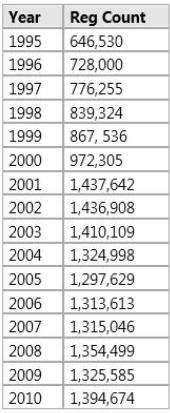Microsoft Implementing Data Models and Reports with Microsoft SQL Server 2012 70-466 Exam Practice Test
You need to create the AD Sales measure.
Which aggregation function should you use?
Answer : D
You are developing a SQL Server Reporting Services (SSRS) report. The report includes a dataset with fields named Year, MonthNumber, and RegCount. The report includes a table that displays the number of recorded registration occurrences per year, as shown in the following table.

You need to modify the table to include a graphical item displaying the monthly registration trend to the right of the Reg Count column.
What should you do?
Answer : E
You need to create a measure for DOD sales.
What should you do? (Each correct answer presents part of the solution. Choose all that apply.)
Answer : A, C
You are developing a SQL Server Analysis Services (SSAS) cube for the sales department at your company.
The sales department requires the following set of metrics:
Unique count of customers
Unique count of products sold
Sum of sales
You need to ensure that the cube meets the requirements while optimizing query response time.
What should you do? (Each answer presents a complete solution. Choose all that apply.)
Answer : B, F
You have a SQL Server 2012 instance that hosts a single-user database. The database does not contain usercreated stored procedures or user-created functions. You need to minimize the amount of memory used for query plan caching.
Which advanced server option should you modify?
Answer : C
The optimize for ad hoc workloads option is used to improve the efficiency of the plan cache for workloads that contain many single use ad hoc batches. When this option is set to 1, the Database Engine stores a small compiled plan stub in the plan cache when a batch is compiled for the first time, instead of the full compiled plan. This helps to relieve memory pressure by not allowing the plan cache to become filled with compiled plans that are not reused.
You need to configure SSRS to meet the maximum number of snapshots requirement.
What should you do? (Each answer presents a complete solution. Choose all that apply.)
Answer : A, C
You are deploying an update to a SQL Server Analysis Services (SSAS) cube to a production environment.
The production database has been configured with security roles.
You need to preserve the existing security roles in the production database. Database roles and their user accounts from the development environment must not be deployed to the production server.
Which deployment method should you use?
Answer : A